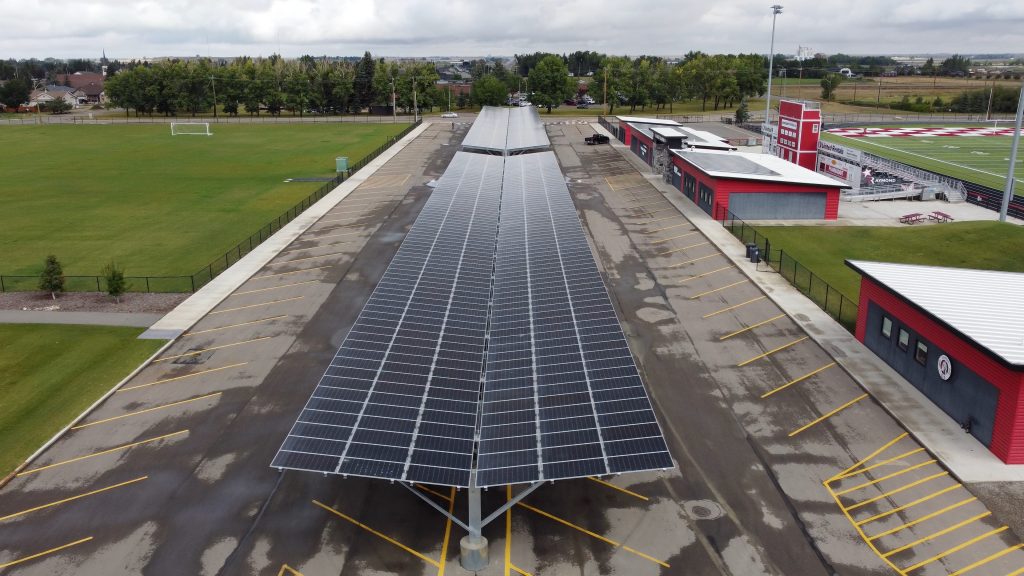Municipalities Taking Climate Action – Part IV
By David Dodge, GreenEnergyFutures.ca
The town of Raymond, Alberta was told that solar wouldn’t work on the buildings in their town in southern Alberta but that didn’t stop them from going solar.
Raymond is a town of 4,200 people located an hour south of Lethbridge and about an hour north of the U.S. border. This is farming country where the sun shines more than any other place in Canada.
The town was interested in solar to help reduce their utility bills, so they hired a consultant to prepare a report.
“Unfortunately, that report at that time turned out to be negative. So, it didn’t look like our buildings were well suited for solar panels and it wasn’t an ideal situation – so we kind of moved on,” says Greg Robinson the director of Community and Corporate Development in Raymond.
Then they noticed their friendly rivals in Cardston (just an hour west) were installing solar.

Keeping up with the Cardstons
“Surely if Cardston can do it, and they’re in a similar geographic area as we are, we can do the same thing,” says Robinson.
The town hired the same consultants Cardston was using and they went to the Municipal Climate Change Action Centre for advice and financial support.
“We were able to quickly mobilize to do an approved project for four buildings here in Raymond,” says Robinson.
Standing between the Raymond Arena and aquatic centre Robinson says they installed solar on the area, aquatic centre, fire hall and the clubhouse at the municipally owned golf course.
Then “We hit a snag on some of our facilities in the sense that we were falling under the microgen provincial rules,” says Robinson.
The microgeneration regulation specifies that you cannot install more solar capacity than your building can consume on a net annual basis.
The trouble is the Raymond Aquatic Centre has a small roof and it uses a lot of power. And besides where do you install solar to power your streetlights?
“It wasn’t a possibility until the province changed the rules,” says Robinson. They now allow municipalities to install enough solar to power things like streetlights at another location.

“It was at that point we decided
that we were all in.”
Greg Robinson, Director of Community and Corporate Development in Raymond.
That was when the town set some big goals. “We wanted to offset all of our consumption on all of our facilities and all of our buildings and become a net zero community,” says Robinson.
The Town of Raymond installed solar everywhere, about 1.3 megawatts in total.
To provide solar power for streetlights and the pool the town built a 383-kilowatt solar canopy in the parking lot at the Victoria Sports Park. The array is quite striking and about 100 meters long.

Thanks to the guidance from the Municipal Climate Change Action Centre the town learned to embrace energy efficiency and solar always with an eye on the economics of each project. Projects must provide a return on investment.
“I’m really proud of the fact that we can take something [like solar], put it on that same tax-supported infrastructure or building, and generate a little bit of income that goes right back to the community … I think it’s a tremendous opportunity,” says Robinson.
They even installed solar at the water treatment plant that they share with several other communities.
The Town has installed level III EV chargers at the arena and the aquatic center and a level II EV charger at the Victoria Sports Park solar canopy. Their maintenance staff travels around town in electric all-terrain vehicles instead of a truck and they replaced all of the golf carts with electric models at the golf course. The town also purchased a plug-in hybrid vehicle.
“We’ve done just about every program the MCCAC has put on the table,” says Robinson.
Raymond Gallery
A little help from their friends
The MCCAC knows that municipalities lack expertise, capacity and resources so they help with advice, grants and programs such as their energy manager program to help small towns and municipalities hire energy managers to help them do the projects to save energy, mone and emissions.
“The MCCAC was a key partner for us … on all of our projects. Small municipalities don’t have that depth of technical experience or staff. And because they’re at arm’s length from the province, there’s a lot of trust implied with the relationship that we had with them,” says Robinson.
It’s a formula that has worked well over the last 15 years. Since 2009 the MCCAC has helped municipalities with 857 projects that will save them $164 million over the lifetime of the projects.
They’ve helped municipalities install 30 megawatts of solar, create 19 climate resilience plans and create jobs in energy efficiency and solar.
Robinson is most proud of the fact that Raymond became the first to achieve net-zero electricity.
“We’ve, we’ve been able to share the good word with other municipal leaders. We’ve probably had about 200 leaders from all over Alberta come to Raymond,” he says.
“I know myself and my CEO, Curtis Prat, have been all over Canada. I’ve been to Montreal to share the message of what Raymond is doing,” says Robinson.
Raymond eclipsed their friends in Cardston on the solar front, but in turn, Cardston was inspired by Raymond to shoot for net-zero electricity. According to Trina Innes, executive director of the MCCAC, “We now have 10 electrically net-zero municipalities in Alberta.”
The work not only inspires other communities to take on energy efficiency and solar projects, but it also has inspired residents of the communities to do the same.

















